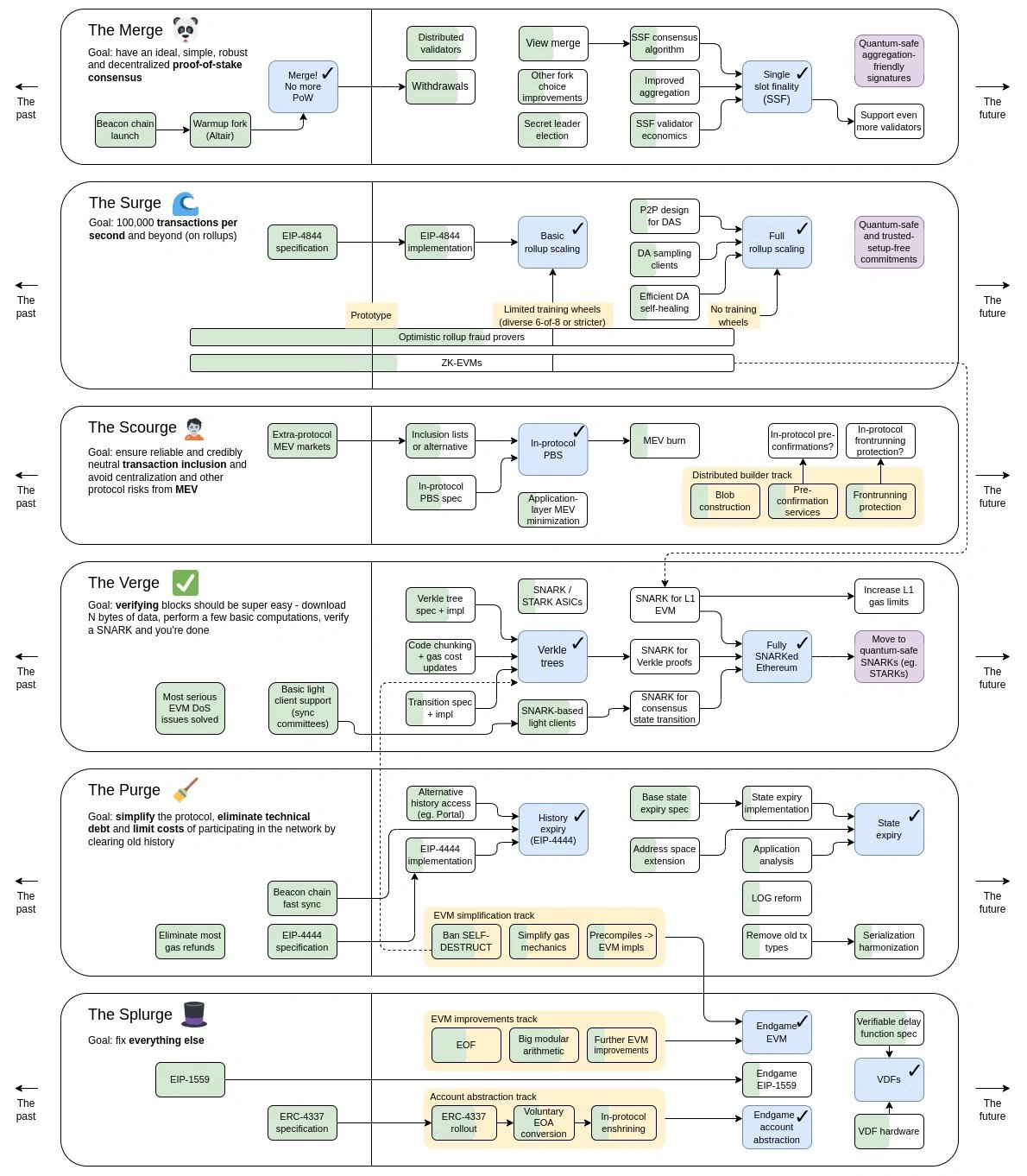위키 구독하기
Share wiki
Bookmark
Dencun Upgrade
Dencun Upgrade
이더리움 덴컨 업그레이드(Dencun Upgrade), 칸쿤-데네브(Cancun-Deneb)로도 알려져 있으며, 이더리움https://iq.wiki/wiki/ethereum 네트워크의 중요한 하드 포크로, 특히 확장성, 효율성 및 보안 측면에서 이더리움이 직면한 몇 가지 주요 과제를 해결하기 위한 것입니다. 칸쿤-데네브 업그레이드라고도 합니다.[21]
개요
덴컨(Cancun-Deneb) 업그레이드는 이더리움의 중요한 하드포크 업그레이드로, 전용 데이터 저장 공간인 데이터 블롭을 도입하여 보조 2계층 네트워크의 거래 비용을 줄이는 것을 목표로 합니다. 이 업그레이드는 이더리움 개발의 중요한 이정표이며, 이더리움 개선 제안(EIPs) 시리즈를 통해 이더리움 블록체인의 확장성, 보안 및 성능을 향상시킬 것입니다.[25]
- EIP-1153: 일시적 저장 opcode
- EIP-4788: EVM의 비콘 블록 루트
- EIP-4844: 샤드 블롭 트랜잭션
- EIP-5656: MCOPY - 메모리 복사 명령어
- EIP-6780: 동일 트랜잭션 내에서만 SELFDESTRUCT
- EIP-7044: 영구적으로 유효한 서명된 자발적 종료
- EIP-7045: 최대 증명 포함 슬롯 증가
- EIP-7514: 최대 에포크 변동 제한 추가
- EIP-7516: BLOBBASEFEE 명령어
덴컨은 이더리움 로드맵의 서지(Surge) 단계의 시작을 알립니다. 이 단계에서 이더리움은 분산화를 유지하면서 대규모 채택을 달성하는 것을 목표로 합니다. 롤업과 같은 2계층 솔루션은 보안을 저해하지 않고 확장성을 달성하는 데 중요한 역할을 할 것입니다.
"덴컨"이라는 이름은 이더리움 블록체인의 양쪽에서 동시에 진행되는 두 가지 업그레이드의 조합입니다.
- Cancun: 모든 프로토콜 규칙이 있는 실행 계층에 중점을 둡니다.
- Deneb: 블록을 검증하는 합의 계층입니다.
덴컨 업그레이드의 주요 목표
- 거래 처리량 증가: 덴컨은 높은 가스 수수료와 네트워크 혼잡으로 이어진 이더리움의 현재 확장성 한계를 해결하는 것을 목표로 합니다. 더 빠른 블록체인과 경쟁력을 갖추기 위해 네트워크가 처리할 수 있는 총 계산량을 늘리는 것을 목표로 합니다.
- 가스 수수료 감소: 거래 처리량을 늘림으로써 덴컨은 네트워크 혼잡을 완화하여 사용자의 가스 수수료를 낮추기를 기대합니다.
- 풀 샤딩을 위한 기반 마련: 덴컨에는 풀 샤딩을 향한 중요한 단계인 프로토-댄크샤딩이 포함됩니다. 샤딩은 블록체인을 더 작고 관리하기 쉬운 조각으로 분할하여 확장성을 더욱 향상시키는 것을 포함합니다.
덴컨 업그레이드는 2024년 3월 13일에 예정되어 있습니다. [4]
칸쿤-데네브 업그레이드를 통해 레이어 2 (L2) 롤업의 데이터 가용성을 확장하기 위한 새로운 거래 유형인 “데이터 블롭” 생성을 통해 이더리움 확장성을 개선하는 데 중점을 두고 있습니다.[19][20]
이더리움 로드맵
| 단계 | 이름 | 목표 |
|---|---|---|
| I | 더 머지 (The Merge) | 지분 증명(PoS) 합의로 전환 |
| II | 더 서지 (The Surge) | 초당 100,000건 이상의 트랜잭션을 처리하는 롤업 중심 확장 |
| III | 더 스컬지 (The Scourge) | 최대 추출 가능 가치(MEV)로 인한 중앙 집중화 및 기타 프로토콜 위험 방지 |
| IV | 더 버지 (The Verge) | 블록 검증을 "매우 쉽게" 만드는 것 |
| V | 더 퍼지 (The Purge) | 프로토콜 단순화 및 네트워크 노드 운영 비용 절감 |
| VI | 더 스플러지 (The Splurge) | "모든 것을 수정" |

이더리움 네트워크
이더리움 네트워크는 실행 계층(Execution Layer)과 합의 계층(Consensus Layer)의 두 가지 주요 계층으로 나뉘며, 덴쿤(Dencun) 업그레이드는 이더리움 네트워크의 실행 계층(Cancun)과 합의 계층(Deneb) 모두에 대한 일련의 개선 사항을 포함합니다.
덴쿤 업그레이드는 상하이 업그레이드와 같은 이전 업그레이드의 성공을 기반으로 이더리움의 지속적인 발전의 일부입니다.[22]
실행 계층
이더리움 실행 계층은 머지 이전 이더리움 메인넷입니다. Eth1으로도 알려져 있으며, 체인에서 스마트 계약 및 트랜잭션을 처리하고 실행하는 역할을 합니다. 실행 계층은 OP 스택의 주요 구성 요소이며, EVM(Ethereum Virtual Machine)이라고도 합니다. 실행 계층 클라이언트의 몇 가지 예는 다음과 같습니다.
- Geth: 전체 CPU를 활용할 수 있는 안정적이고 신뢰할 수 있는 다중 스레드 실행 클라이언트
- Nethermind: 일반 사용자와 엔터프라이즈급 dApp에 적합한 .NET Core 기반 이더리움 실행 계층 클라이언트 [2]
실행 계층 하드 포크는 이전에 Devcon을 개최했던 도시의 이름을 따서 명명됩니다: Berlin -> London -> Shanghai -> Cancun -> Prague -> Osaka -> Bogotá.
EIP-5656 및 EIP-6780은 Cancun 관련(실행 계층) 업그레이드입니다. [1]
컨센서스 계층
컨센서스 계층은 모든 노드 간 네트워크 상태에 대한 합의를 담당합니다. 모든 트랜잭션과 스마트 계약이 지분 증명(PoS)을 통해 검증되고 합의되도록 합니다. 이더리움의 컨센서스 계층(Eth2)은 블록체인에 대한 일련의 업그레이드입니다. 업그레이드의 목표는 블록체인의 속도와 용량을 개선하고, 트랜잭션 비용을 줄이며, 보안을 강화하는 것입니다. 어떤 트랜잭션이 발생했는지, 언제 발생했는지, 어떤 순서로 발생했는지에 대한 모든 정보를 동일하게 유지합니다. 컨센서스 계층은 또한 시간 측정, 난수 생성, 스테이킹 작업, 거버넌스 메커니즘을 포함한 네트워크에 여러 가지 중요한 서비스를 제공합니다. [1] 2022년 9월, 이더리움은 작업 증명(PoW)에서 지분 증명(PoS)으로 전환함으로써 컨센서스 메커니즘을 성공적으로 변경했습니다. 이 전환은 머지(The Merge)로 알려져 있습니다. [3]
각 컨센서스 계층 업그레이드에는 별의 이름이 지정되며, 이름은 첫 글자를 기준으로 알파벳 순서로 선택됩니다: Altair -> Bellatrix -> Capella -> Deneb -> Electra -> (F)unknown. [1]
덴컨 업그레이드에 통합된 EIP들
EIP-1153: 일시적 저장 opcode
EIP-1153은 일시적 저장 opcode를 도입하여 스마트 계약 실행 중 저장 작업과 관련된 비효율성과 비용을 줄이는 것을 목표로 합니다. EIP-1153은 이더리움 블록체인에서 트랜잭션 실행 최적화에 있어 상당한 발전을 제시합니다. EIP-1153은 가스 비효율성을 해결하여 스마트 계약 성능을 향상시킵니다. [9][6][10][18]
EIP-4788: EVM의 비콘 블록 루트
EIP-4788은 이더리움 가상 머신(EVM)에서 비콘 체인 블록 루트를 공개하는 것을 제안합니다. 비콘 체인 블록 루트는 임의의 합의 상태를 증명하는 데 사용되는 일종의 누산기입니다. 이더리움 가상 머신에서 비콘 체인 블록 루트를 공개함으로써 최소한의 신뢰로 이더리움 합의 계층에 접근할 수 있습니다. 이 개선 프로토콜은 스테이킹 풀 및 스마트 계약 브리지와 같은 사용 사례 개발을 용이하게 하여 신뢰 가정을 향상시킵니다.
EIP-4788은 이더리움 합의 상태에 대한 정보를 얻는 데 있어 신뢰할 수 있는 오라클 솔루션의 필요성을 없애줍니다. Lido 및 Rocket Pool과 같은 리퀴드 스테이킹 풀과 EigenLayer와 같은 재스테이킹 애플리케이션이 이점을 얻을 수 있습니다.[5][6][7][17]
EIP-4844: 샤드 블롭 트랜잭션
EIP-4844(EIP-4844), 프로토-댄크샤딩(Proto-Danksharding)으로도 알려진 이 최근 제안은 이더리움의 L2 구조를 확장하여 롤업이 내장 데이터에 대한 새로운 수수료 시장을 활용할 수 있도록 하는 것을 목표로 합니다. 이 개선 제안은 샤딩(샤딩), 이더리움의 계층 1 확장 전략이 구현될 때까지 롤업을 통해 이더리움을 확장하기 위한 임시 방편으로 제시됩니다.
EIP-4844의 변경 사항은 향후 샤딩 솔루션과 호환되므로 준비가 되면 원활한 샤딩 구현이 가능합니다.[8][6][19]
EIP-5656: MCOPY - 메모리 복사 명령어
EIP-5656는 EVM에서 데이터 이동 방식의 효율성을 높이기 위한 새로운 opcode의 사전 구현입니다. 구체적으로, EIP-5656는 MCOPY로 알려진 새로운 EVM 명령어를 도입합니다.
MCOPY는 EVM 내에서 메모리 복사 성능을 최적화하도록 설계되어 데이터 구조 생성을 위한 더 효율적인 방법을 제공합니다. 소스 포인터와 대상 포인터 두 개의 메모리 포인터를 입력으로 받아 소스 포인터의 데이터를 대상 포인터로 복사합니다. 복사할 데이터의 크기는 세 번째 입력 매개변수로 지정됩니다.
바이트 단위로 데이터를 복사하는 루프를 사용하는 현재 EVM의 메모리 복사 방법보다 효율적입니다. MCOPY는 데이터를 일괄적으로 복사할 수 있으므로 훨씬 빠릅니다. 또한 현재 메모리 복사 방법보다 간결하다는 장점도 있습니다. MCOPY를 사용하면 스마트 계약 작성 및 읽기가 더 쉬워집니다.[1][15]
EIP-6780: 동일 트랜잭션 내에서만 SELFDESTRUCT 사용 가능
EIP-6780은 현재 이를 사용하는 스마트 계약에 최소한의 지장을 주면서 SELFDESTRUCT opcode의 기능을 제한하도록 설계되었습니다. 이 제안은 향후 이더리움 애플리케이션에 사용될 Verkle Tree 아키텍처를 준비하기 위해 SELFDESTRUCT opcode의 기능을 수정합니다.
현재 이더리움 애플리케이션은 Merkle Tree 아키텍처를 사용하며, SELFDESTRUCT opcode는 코드 및 스토리지 삭제와 같은 계정 상태에 대한 중요한 변경을 수행하는 데 사용될 수 있습니다. 그러나 향후 이더리움 애플리케이션에서 Verkle Tree 아키텍처가 사용되면 Verkle Tree 아키텍처가 각 계정을 루트 계정과 연결되지 않은 다른 계정 키에 저장하기 때문에 계정을 수정하거나 삭제하기가 어려워집니다.
따라서 EIP-6780은 SELFDESTRUCT opcode의 기능 수정을 제안합니다. EIP-6780에 따르면, 수정된 SELFDESTRUCT opcode는 스마트 계약이 생성한 동일한 트랜잭션에서 호출되는 경우를 제외하고는 더 이상 계정을 변경하거나 삭제할 수 없으며, 호출자에게 ETH를 전송하는 데만 사용됩니다.[1][14]
EIP-7044: 영구적으로 유효한 서명된 자발적 탈퇴
EIP-7044는 이더리움 네트워크의 기존 서명된 자발적 탈퇴의 유효 기간과 관련된 중요한 제한 사항을 다룹니다. 현재 이러한 탈퇴는 다음 두 번의 네트워크 업그레이드에만 유효하며, 특히 스테이킹 운영자가 자금 소유자와 다른 경우 복잡한 문제를 야기합니다.
이 제안은 Capella 블록체인에서 서명된 자발적 탈퇴에 대한 "영구 유효성" 채택을 유도하여 향후 업그레이드에 관계없이 무기한 유효하게 유지하는 것을 목표로 합니다.
이 제안의 주요 목표는 스테이킹 운영의 설계를 단순화하고 사용자 경험을 향상시키는 것입니다. 이는 운영을 간소화하고, 합의 계층 호환성을 보장하며, 사전 서명된 탈퇴를 Capella 포크 도메인으로 전환하도록 규정합니다. 이 제안은 스테이킹을 단순화합니다.[11][16]
EIP-7045: 최대 증명 포함 슬롯 증가
EIP-7045는 증명의 최대 포함 슬롯을 확장하여 Ethereum 네트워크에 중요한 변화를 도입합니다. 이 제안은 이더리움의 합의 메커니즘의 보안 및 효율성을 향상시키고자 합니다. 현재 증명은 포함될 수 있는 기간이 제한되어 있지만, EIP-7045는 그 기간을 넓혀 다음 에포크가 끝날 때까지 증명이 유효하도록 합니다.
이러한 변화는 LMD-GHOST 보안 증명에 대한 이해가 발전하고 새로운 확인 규칙이 필요하다는 점에 뿌리를 두고 있습니다. 증명이 더 오랫동안 유효하도록 함으로써 이더리움은 보안을 향상시키는 동시에 성능도 향상시킬 수 있으며, 특히 블록 확인을 더욱 신속하게 처리할 수 있습니다.[13][16]
EIP-7514: 최대 에포크 변동 제한 추가
EIP-7514는 이더리움 비콘 체인의 에포크 변동률을 제한하여 검증자 성장률을 기하급수적에서 선형적으로 전환하는 것을 목표로 합니다. 이 조치는 대규모 검증자 집합을 관리하는 이더리움 클라이언트의 확장성 문제, 유동적 스테이킹 플랫폼인 Lido의 지배력으로 인한 잠재적인 중앙화 위험, 그리고 솔로 스테이커의 재정적 부담에 대한 우려에 대한 대응입니다.
EIP-7514는 이더리움 개발자와 이해관계자에게 장기 전략을 마련할 시간을 더 확보하기 위해 검증자 변동률을 제한하는 단기적인 해결책을 도입하고자 합니다.[12][18]
EIP-7516: BLOBBASEFEE 명령어
EIP-7516은 이더리움에 BLOBBASEFEE opcode를 도입하여 스마트 계약이 체인 상의 데이터 블롭에 대한 현재 기본 수수료에 직접 접근할 수 있도록 합니다. 이는 롤업 계약이 데이터 블롭 비용을 보다 효율적으로 관리하고 예측하는 데 도움이 됩니다.
BLOBBASEFEE 명령어는 실행 중인 현재 블록의 블롭 기본 수수료 값을 반환합니다. EIP-3198에 정의된 BASEFEE opcode와 동일하지만 EIP-4844에 따른 블롭 기본 수수료를 반환합니다.[23][24]
잘못된 내용이 있나요?
